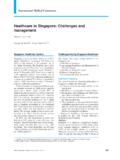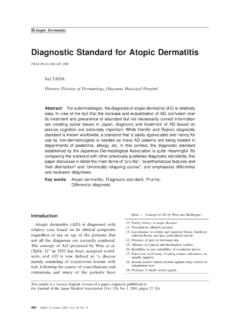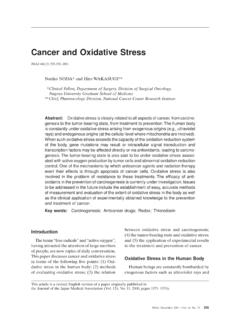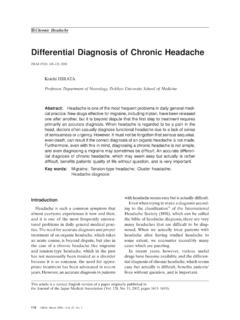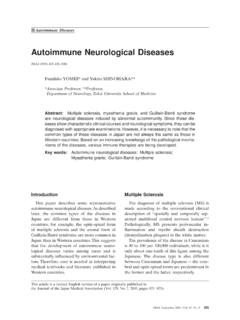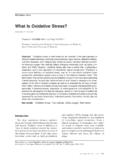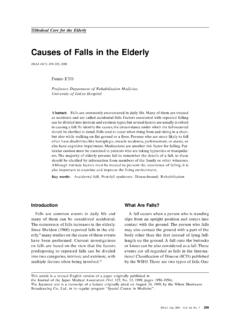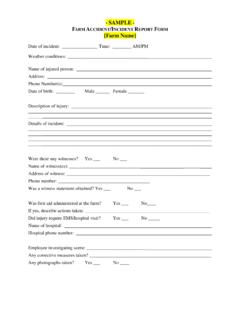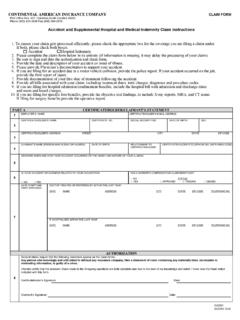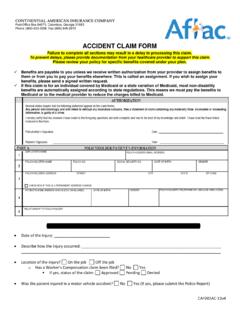Transcription of APPROACH TO RISK MANAGEMENT IN MEDICAL …
1 Feature: Risk MANAGEMENT in MEDICAL Practice 1. APPROACH TO RISK MANAGEMENT . IN MEDICAL PRACTICE: STANDPOINT OF A HOSPITAL*. Shozo MIYAKE**. Asian Med. J. 44 (1): 1 10, 2001. Abstract: There had been a number of incidences of MEDICAL malpractice at Musashino Red Cross Hospital, and since 1995 the hospital has been engaged in activities to prevent MEDICAL malpractice . In the early days, efforts were focused on quality control (QC) by introducing an incident reporting system that was pat- terned after risk MANAGEMENT techniques developed in the field of aviation. To evaluate these incident reports, a Committee to Assess MEDICAL Services (later renamed the MEDICAL Risk MANAGEMENT Committee) was established. Every month this committee reviews each incident from the standpoint of MEDICAL technology, MEDICAL judgment, human factors, labor conditions, hospital systems, and the super- visory functions of the hospital.
2 The results of these evaluations are used to improve defects in the above system. The committee also conducts MEDICAL audits in the hospital. Our APPROACH to the prevention of malpractice is described in this paper. Key words: Risk MANAGEMENT in health care; MEDICAL risk MANAGEMENT ;. Policies to prevent MEDICAL malpractice Introduction Generally speaking, when an accident occurs in an industry, every effort pos- sible is made to prevent a recurrence, thereby minimizing the risk of recurrence of the same type of accident within that industry. In health care, however, accidents of the same type repeatedly occur in the same hospital. One might even suspect that it is impossible to learn from mistakes in medicine. Confronted with this situation, there is apprehension that doctors in a team practice may lose the trust that the other team members have always placed in them.
3 To improve this situa- tion, hospitals must make efforts systematically to change health care risk manage- ment so that MEDICAL malpractice can be prevented. On the other hand, human beings always make mistakes, therefore, making every effort to prevent errors and provide safe and high-quality health care is the most important mission of health care organizations, and the practices employed at the Musashino Red Cross Hospital are described below from this standpoint. * This article is a revised English version of a paper originally published in the Journal of the Japan MEDICAL Association (Vol. 123 No. 5, 2000, pages 622 628). ** Vice President, Musashino Red Cross Hospital 2 S. MIYAKE Asian Med. J. 44(1), 2001. The first goal we set in our attempt to prevent MEDICAL malpractice was to raise the awareness of those in the frontlines of MEDICAL practice.
4 We believed that quality control (QC) activity was the most appropriate means for this purpose and organized a QC group in each work unit in a top-down format. The head of each section was to lead the group, and a total of 11 groups were formed. First, they set the major goal of prevention of malpractice and selected topics accordingly. Each group held meetings once a month, from which we learned a great deal. However, the majority of the topics of the QC activities concerned problems related to nurses alone, and because the results of the discussions overlapped accident prevention activities in the nursing section and measures to improve nursing works, the burden on the nurses became even more onerous. After about 2 years, all QC group activities ceased. These initial efforts, however, established the basis for future activities to prevent MEDICAL malpractice in our institution.
5 We came to realize that the QC. activities must be reorganized in the original bottom-up format, and we are cur- rently engaged in reorganizing our improvement activities, with the support of the Union of Japanese Scientists and Engineers. Construction of a MEDICAL Risk MANAGEMENT System within an Organization 1. The nursing section The nursing section has traditionally been involved in efforts to prevent medi- cal malpractice. In association with this new venture, they revised their accident report forms, organized a committee to prevent accidents within the nursing section, reviewed accident reports forwarded from the wards, and fed the results back to the meetings of the chief nurses. The nursing section drew up a manual called Accident Prevention within a period of 18 months. Since early 1999, a risk MANAGEMENT nurse has been assigned to each ward to gather and analyze informa- tion on each incident and send back the details of the analysis in the form of feedback (Fig.)
6 1). 2. Doctors There are numerous problems concerning doctors, and policies affecting doc- tors will be mainly presented in this section. Traditionally, doctors have seemed to regard themselves as privileged and expected everyone else to serve them, this attitude may have helped doctors to become self-righteous. Doctors have tended to avoid disclosing the details of their practice in investigations of MEDICAL malpractice, always leaving behind a so-called gray zone . However, the modern societies offer a wealth of MEDICAL information, and the public is better informed than ever. If doctors do not shake themselves free of their arrogant attitude, it may be impossible to prevent recurrences of MEDICAL malpractice, and doctors, as leaders of the health care groups, may lose the trust of the other team members. Faced with the situation described above, our programs were undertaken.
7 Another motivation for starting these programs was doubts about the appro- RISK MANAGEMENT FOR HEALTH CARE 3. Director MEDICAL Disputes Risk MANAGEMENT MEDICAL Affairs Conference General Risk Manager (Vice President). President, Vice president, Head of the nursing department, MEDICAL Risk MANAGEMENT Committee Head of the business department, Head of the general affairs section Physician, Pharmacist, MEDICAL technologist, Business section staff, Risk MANAGEMENT nurse Business MEDICAL Laboratory MEDICAL Nursing section department social department department service Pharmacy Head of the nursing section department department Risk MANAGEMENT Nurse Nurse Risk MANAGEMENT Committee Risk Manager Risk Manager Section Section Section Department Department Head of Head of Head of head head head head head nursing nursing nursing section section section Department Department Head of Head of head head nursing nursing section section Fig.
8 1 Organizational chart of MEDICAL risk MANAGEMENT (Musashino Red Cross Hospital, June 1, 1999). priateness of our former method of hospital MANAGEMENT . There are a number of MEDICAL departments within a hospital, and each operates within its own specialty. If each operates independently without regard for the other departments, the cohesion desired in a hospital is lost. Organized health care becomes possible only when the goals and quality of MEDICAL service of the hospital as a whole are main- tained and managed. We believe that there is a definite need for a system to monitor the health care actions of the hospital as a whole. Introduction of an Incident Reporting System Following the advice of Dr. Isao Kuroda, then a professor in the School of Human Science of Waseda University, who suggested the introduction of risk MANAGEMENT technology that had been developed in the field of aviation because malpractice in health care resembles the accidents that occur in association with aviation (1995), we decided to adopt the risk MANAGEMENT incident reporting system for doctors.
9 There is a well known saying that there is a chain of events in aviation accidents, because 3 or more minor incidents always occur in a row before a larger, more serious accident. Every pilot is instructed to faithfully report every incident that occurs during a flight regardless of its seriousness (including near-miss 4 S. MIYAKE Asian Med. J. 44(1), 2001. Incident/Accident Report (Circle one) Date: , 200. Work site Position Years of work experience Name Years (Personal seal). Patient's name Age Diagnosis (male or female). Site of the accident Ward Department on an outpatient basis occurred Date and time of Date: Time: the accident Date the accident was Date: Time: discovered Time treatment was Date: Time: started Time a report was made Date: Time: to the department head Type of accident [Classification] 1. oversight or misunderstanding, 2. misidentification, [Classification] 3.)
10 Error in dosage, 4. complication, 5. iatrogenic disease, 6. others Process during which the accident happened Response and steps taken after the accident Explanation given after the accident and the subsequent response of the patient Evaluation of the gravity Llife-threating: very grave; grave; possible; little; none of the risk involved Patient's trust: greatly damaged; slightly damaged; not much affected in the accident Health status of good; physically fatigued [ by work; for personal reasons]. the MEDICAL personnel good; psychologically fatigued [ by work; for personal reasons]. involved others (remarks: ). Views on the cause of the accident [Classification] 1. lack of observation, 2. delay in testing, 3. delayed diagnosis, [Classification] 4. inadequate technology, 5. surgical mistake, [Classification] 6. inadequate communication, 7. inadequate explanation, 8.
